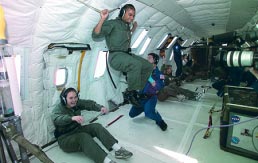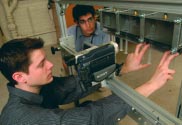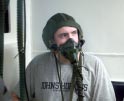
It’s a basic law of physics: What goes up must come down. However, fly in the “Vomit Comet,” and you hope nothing comes up at all.
That might have been on the minds of a group of seven Johns Hopkins University undergraduates, collectively known as Team STILLMix, as they got their first look at the gleaming KC-135 aircraft inside a hanger at the Johnson Space Center near Houston, Texas, in early April. The National Aeronautics and Space Administration (NASA) uses the jet with the colorful nickname for high-altitude microgravity experiments.
“Vomit Comet” refers to its tendency to induce motion sickness during its roller-coaster rides. The plane flies in tight parabolic arcs, using centripetal acceleration to balance the force of gravity at the top of the arc, achieving microgravity conditions for up to 23 seconds. Astronauts and aerospace researchers use these brief moments of near-weightlessness to prepare for space flight and to conduct experiments.
Undaunted, on the morning of April 17, Team STILLMix was eager for lift-off. The team members are Henry Mowry Cook III ’04 (a double major in Physics and Engineering Mechanics); Paul Gosling ’03 A&S and Paul Nerenberg ’04 A&S (Physics majors); Sara Marten ’04, Mike Sharma ’04, and Yo-Rhin Rhim ’03 (Mechanical Engineering majors); and Sam Phillips ’04 (a Civil Engineering major). Their faculty advisor is Cila V. Herman, professor of Mechanical Engineering.
It all started last October, when Lani Hummel, director of the Whiting School of Engineering’s Office of Industrial Initiatives, received an e-mail from Anne Anikis, assistant director of the Maryland Space Grant Consortium. “NASA was accepting research project proposals from college students for its near-zero gravity plane,” Hummel explained. “I called Mowry Cook and said, ‘See if you can develop a research experiment surrounding this with some of your friends, and I’ll find a corporate sponsor.’”
Cook took up the challenge. He admitted in April, “I’ve never really done anything like this.” He was speaking on a mobile phone from the hanger in Houston, where he and his fellow students were preparing the experimental instrument they designed and built. “It’s been a huge learning experience. We could get some really good science out of it,” Cook affirmed.
And they did. The team members scheduled to fly all reported successful flights. Their experiment involved “surface tension impelled low gravity liquid mixing,” or STILLMix for short. To get from concept to Comet took more than classes, tests, theories, and homework. “These kids had to learn so much,” Hummel said. They had to come up with an original idea and submit their proposal to NASA’s Reduced Gravity Student Flight Opportunities Program.
Once the students’ proposal was accepted, then the work really began. They had to find financial supporters for their project, design it, run computer simulations, requisition supplies, create budgets, set deadlines, negotiate equipment purchases, train physically, manage the entire process, pack their instrument so it wouldn’t break, make travel arrangements, and set up outreach presentations at area high schools. “This is a very valuable experience,” Hummel emphasized. “They wouldn’t get it any other way.”
Their sponsors included the Whiting School, the Krieger School of Arts and Sciences, Kathleen Sharma, the Maryland Space Grant Consortium, the National Office of the Society of Physics Students, Northrop Grumman, and William and Dorothy Nerenberg.

Their experiment aimed to improve understanding of how near-zero gravity affects the surface tensions, and thus, the mixing, of liquids. The STILLMix apparatus was a rectangular aluminum frame with 18 individual chambers for mixing fluids. The team tested four liquids—water, silicone oil, ethyl alcohol, and minimal essential medium—in various combinations. They dyed each liquid to make its behavior easier to see, and used a mounted digital video camera to record each test to facilitate closer analysis back in the lab.

Learning more about how liquids mix and spread on a surface in weightless conditions is important, the students say, because moving fluids aboard a spacecraft by mechanical devices AWARDS requires power, which must be conserved as much as possible in space. For some experiments, explained Cook, “we put small pieces of Teflon tape” on the surfaces to see how it would influence the mixing. “As a passive technique, it requires no additional energy,” he continued, which is good, because using more energy “adds expense, weight, and complexity.” Their research also might shed light on whether astronauts could manufacture spare parts in space through a plastic injection molding process.
Hopkins honored Team STILLMix with a Provost’s Undergraduate Research Award. These awards, funded by the Hodson Trust, provide up to $2,500 for original research.
There was another mixing going on here as well: Juniors and seniors from many disciplines, combining many talents, took on a project with countless challenges. Stir in the chance to rub shoulders with working engineers at NASA, and the STILLMix project starts looking like a heady blend of meaningful learning. According to Gosling, the team leader, “There are things you just can’t learn in the classroom, and it’s good to get out of a theoretical setting. What we are doing here is more like the real world.”
Visit the Team STILLMix web site for flight photographs, team résumés, experiment results, and other links at www.wse.jhu.edu/~stillmix /index.html




